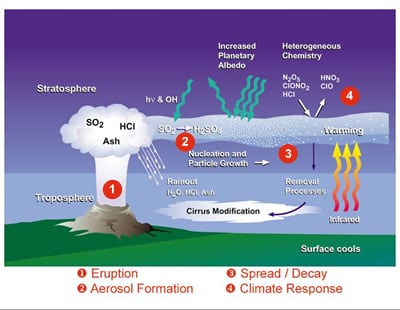- The volcanic ash cloud created by a volcanic blast can change interactions between the atmosphere and sun, affecting climate patterns.
- When a volcano erupts, the main things that come out of it are sulfur dioxide, water vapor, dust, and ash that go into the atmosphere.
- The eruption of a volcano can cause a cooling or warming effect on the Earth’s surface.
- So, large eruptions usually cause the cooling effect because they’re able to blast sun-blocking particles all the way up to the stratosphere.

Materials released:
- Lava (molten rock) Ash
- Carbon Dioxide + Monoxide (CO2, CO)
- Sulfur Dioxide (SO2)
- Hydrogen + Sulfide (H, H2S)
- Other gasses (CH4, O3, etc.)
How does it affect climate?
- Ash generally remains suspended in the air for a period of time, increasing the earth’s albedo.
- The ash prevents full sunlight from entering the earth, causing the temperature to cool immediately after the eruption.
- However, once ash disperses over a larger area, newly emitted greenhouse gasses result in a marginal increase to average temperature.
- Compared to greenhouse gasses emitted from industry, volcanic gasses are relatively small in amount (135:1)
- Lava may burn or destroy the surrounding region resulting in either heating or cooling depending on what is destroys e.g. burned forests would result in some warming due to increased CO2 levels.
- Sulfuric acid may form in the atmosphere, resulting in acid rain.
Cooling effect
- Sulfur dioxide combines with water to form tiny droplets of sulfuric acid.
- These droplets condense quickly in the atmosphere to form sulfate aerosols.
- These aerosols reflect sunlight away from Earth’s surface back into space, cooling the Earth’s lower atmosphere and troposphere.
- This is a positive feedback loop because the result causes the process to occur more.
- Volcanic eruptions that are powerful enough to emit thousands of gases into the atmosphere can reduce the amount of solar radiation reaching the Earth’s surface which can make the climate colder.
Warming effect
- The eruption of a volcano also throws out carbon dioxide into the atmosphere.
- Since carbon dioxide is a major greenhouse gas, it traps heat radiated off of the surface of the Earth forming a type of insulation around the planet.
- In fact, according to the British and US Geological Survey, underwater and land-based volcanoes are estimated to release around 100-300 million tonnes of carbon dioxide each year.
- While carbon dioxide and water are gases in the atmosphere, they absorb infrared heat radiation which causes the air below it to get warmer.
- The movement of plates also causes volcanoes to form and they can contribute to the climate getting warmer since they throw gas and dust particles into the atmosphere which interact with sunlight.
